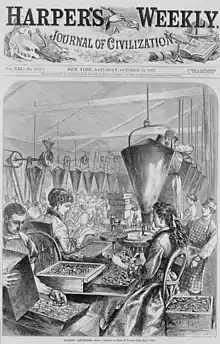.43 Spanish
The .43 Spanish was a centerfire firearms cartridge developed by Remington designers around 1867.[2] It was used in early rolling block rifles that Remington manufactured for the government of Spain. The cartridge is also referred to as the .433 Spanish,[3] "11mm Spanish", and identical cartridges for the US Peabody rifle were marked "U.M.C. 43-77".[4]
| .43 Spanish 11mm Spanish 11.15×58mmR Spanish Remington U.M.C. 43-77 | |
|---|---|
 | |
| Type | Rifle |
| Specifications | |
| Bullet diameter | 11.15 mm |
| Neck diameter | Bottleneck[1] |
| Overall length | 2.845 in |
| Primer type | Berdan |

History
The .43 Spanish cartridge was produced after Spain purchased the newly invented rolling-block action. The breech-loading firearm, which was marketed by Sam Remington, impressed the Spaniards after their own evaluation.[5] In 1869, the Spanish government put in an order for 10,000 rifles.[6] Aside from the firearms, however, they also wanted their own cartridge and Remington manufactured the .43 Spanish.[6] It was produced in two variants: the bottlenecked .43 Spanish (11.15 x 57R Remington Spanish) and the straight-walled case .43 Spanish Reformado (11.4 x 57R Reformado).[2]
The cartridge was almost similar to the .44-77 cartridge except for the difference in their diameters.[7] The Spanish military version of the cartridge was later upgraded in 1889 to a "heavier, brass-jacketed reformado bullet".[8] While Remington stopped manufacturing the cartridge in 1918, its use in the United States became widespread after World War II because it was sold as a surplus.[9]
"Poison bullet"
The .43 Spanish used a .454-inch diameter bullet that weighed 396 grains. Its 1,280 fps was powered by 74 grains of powder.[5] Instead of solid lead bullet, the .43 Spanish used a brass-jacket bullet, which was considered unusual because cupronickel, gilding metal, and copper clad steel were preferred for bullet jackets during the period.[10] It was also the reason why American soldiers suspected that the Spaniards used poison in their bullet during the Spanish-American War.[10] It corroded in the tropics, producing a powdery pale green verdigris once they are exposed to high humidity or salty sea air over time.[10] The brass component, however, improved bullet penetration.[10]
Firearms chambered
- Argentine Modelo 1879, rifle and carbine[1]
- 1869 Spanish Peabody[11]
- Whitney–Burgess–Morse lever-action rifle (military version)[12]
- Model 1879 Remington–Lee[13]
References
- Roy Martin Marcot (2005). The History of Remington Firearms. Lyons Press. p. 53. ISBN 978-1-59228-690-4.
- Thombs, David A., and Barrett, Stephen P. The internet and firearms research with reference to the .43 Spanish Remington Rolling-Block and its ammunition, The Journal of the Historical Breechloading Small Arms Association, Vol.4, No.4, pp. 14–23
- ".43 Spanish". Roberson Cartridge Company. 2019-12-12. Retrieved 2021-09-22.
- Fred A. Datig (1958). Cartridges for Collectors: Center fire, rimfire, patent ignition. Borden Publishing Company.
- "Thoughts on the .43 spanish and the Remington Rolling-Block Rifle | Black Powder Cartridge". www.blackpowdercartridge.com. Retrieved 2021-09-22.
- David F. Butler (1971). United States Firearms: the First Century, 1776–1875. Winchester Press.
- Flatnes, Oyvind (2013). From Musket to Metallic Cartridge: A Practical History of Black Powder Firearms. Crowood. ISBN 978-1-84797-594-2.
- Alejandro de Quesada (2012). The Spanish–American War and Philippine Insurrection. Bloomsbury Publishing. p. 92. ISBN 978-1-78096-353-2.
- ".43 Spanish". Roberson Cartridge Company. 2019-12-12. Retrieved 2021-09-22.
- Rottman, Gordon L. (2013). The Book of Gun Trivia: Essential Firepower Facts. Osprey Publishing. pp. 182–183. ISBN 978-1-78200-621-3.
- Philip Peterson (2011). Standard Catalog of Military Firearms: The Collector's Price and Reference Guide. F+W Media. p. 315. ISBN 978-1-4402-2881-0.
- Jerry Lee (2013). The Official Gun Digest Book of Guns & Prices 2013. Krause Publications. p. 1229. ISBN 978-1-4402-3543-6.
- Dan Shideler (2008). Standard Catalog Of Remington Firearms. F+W Media. p. 104. ISBN 978-1-4402-2699-1.
Further reading
- Croft Barker. Shooting the .43 Spanish Rolling Block. Cistern Publishing, 2003. ISBN 0971512833
- Thombs, David A., and Barrett, Stephen P. The internet and firearms research with reference to the .43 Spanish Remington Rolling-Block and its ammunition, The Journal of the Historical Breechloading Small Arms Association, Vol.4, No.4, pp. 14–23
External links
- .43 Spanish Remington, Cartridge Collector